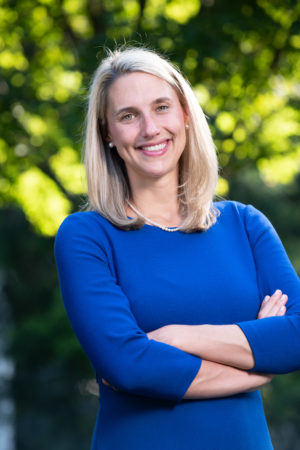Stamford Mayor Simmons asserts bright near-future for city
Stamford Mayor Caroline Simmons erred on the side of safety in not attending the Stamford Chamber of Commerce’s recent State of the City address ”“ her husband, former state senator Art Linares, had tested positive for Covid-19 earlier in the day, and Simmons herself tested positive after the event as well.
But Simmons, in a recorded video message, noted that the pandemic has yet to be tucked into the history books and praised Stamford’s frontline heroes for their work in keeping the city safe and functioning during the health crisis.
“I want to recognize our dedicated first responders, health professionals, teachers, police officers, firefighters, EMS officials and our nonprofit business leaders who came together under unprecedented circumstances to keep our community safe and protect the most vulnerable among us,” she said.
Simmons also pointed out the economic challenges fueled by the pandemic, including rising inflation, supply chain issues, the sudden need for child care due to school closures —challenges that continue to exist. Still, she defined spring as a time of renewal and stressed that Stamford was poised to stand strong.
“The top priorities my administration is focused on include advancing economic prosperity, investing in Stamford’s infrastructure and making the government more responsive,” she said.

Simmons also underlined that Stamford’s unemployment rate of 4% compared favorably to Connecticut’s overall rate of 4.4%, and that it has been achieved after a recent peak of 10% unemployment. Over the past two years, that growth has likely been driven in part by 10,000 new residents, many transplants from New York City.
Simmons indicated that all of this has put the city in a position to “capitalize on this unique moment in time and to move our city forward, to be one of the brightest, most successful cities in the state, if not the country.”
To ensure that future, Simmons laid out a series of steps being taken to improve specific aspects of Stamford’s appeal to business. This included a proposal for a $15 million grant in state funds to help establish a branch or new campus of a major university with a focus on fintech, a move she likened to Michael Bloomberg’s work to establish Cornell Tech on Roosevelt Island.
“We have the opportunity to attract a world-class fintech university here in Stamford,” Simmons continued, “to provide students with learning and internship opportunities, to create over 10,000 jobs and to build our tech workforce.” She noted that nine out of 10 jobs in the future are expected to require additional tech skills not typically taught in high schools.
Simmons also outlined a confident assertion that the city’s AAA bond rating and financial windfalls in recent years will make all of this possible with a tax increase of less than 1%.
Business retention was another priority Simmons cited, pointing out that her administration launched the Mayor’s Business Advisory Council to ensure that employers feel that their voices are heard by her office. According to Simmons, efforts to revitalize the Stamford train station and streamline the city’s permitting process are the first fruits of that labor.
To bolster retention efforts, she announced plans for the launch of a Small Business Resiliency Program, which will use some of the city’s remaining Covid funding. The program will have a special emphasis on women-and-minority-owned businesses.
Simmons then turned her focus to efforts for attracting new businesses, particularly in providing spaces for entrepreneurs in the food industry to join the community. She called attention to the $2 million in state funding, which will be used to create a “Food Truck Park” on Pacific Street and added that her office is working to pass an ordinance that will permanently allow some of the outdoor dining options permitted under Covid emergency measures.
Simmons also encouraged residents to use the FixIt Stamford Portal to direct road maintenance inquiries to where it is most needed, and she envisioned larger transportation improvements, including both expanded trolley service and an exploration of a possible ferry to New York City.